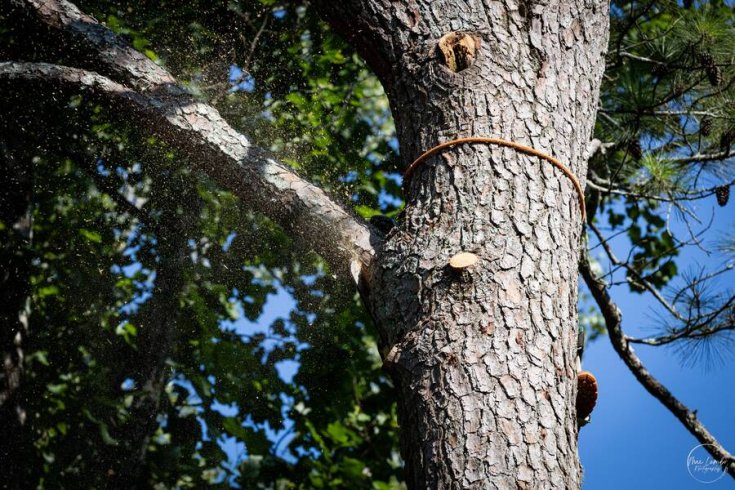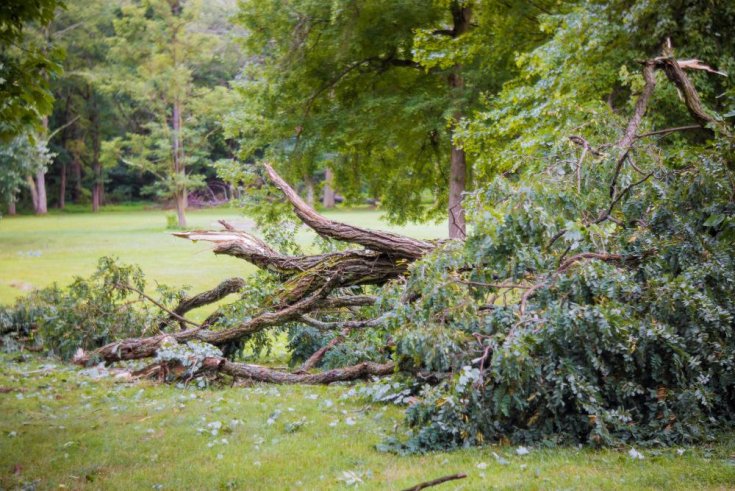Menu
There’s nothing more spectacular than the fantastic spectrum of colors as different trees bloom. Whether you appreciate the distinct scent of blooming pine cones or despise the memory of stepping on mushy fruits, trees don’t produce these things to annoy us. This is the backbone of creating a new generation of trees. The goal of reproduction is the same in animals and plants, but the method is different.

At Driscoll Tree Service, understanding trees’ reproductive process helps provide better care based on the season. It also helps our tree service technicians predict which trees shed more pollen and produce fruit to ensure you plant the right tree for your needs. The last thing you want is a tree that sheds pollen profusely, and you are allergic. Our tree care company can ensure your trees are in tip-top condition throughout the year.

A flower is the reproductive organ of a plant, containing different parts that help it serve this purpose better. There are four main parts of a flower that you should know: sepals, petals, anthers, and pistils. The sepals act as the protective shield that prevents damage to fragile parts from foreign material. Petals are aesthetically pleasing, attracting animal pollinators and people.
The anthers are the male reproductive organs, producing pollen that fertilizes the stigma where the female reproductive organ is located. The pistil is the female reproductive organ that produces the seeds to be fertilized to produce fruits. Now that you know a flower’s different parts, let’s look at the different reproduction categories.
Cosexual trees have both female and male reproductive parts. Broadleaf trees usually have these types of flowers, with most of them being insect-pollinated and showy. If you are looking for an ornamental tree for your home, these trees are the ideal choice. Insect pollination is more effective and less likely to cause allergies, making them perfect if pollen triggers an allergic reaction. Significant examples include magnolia, cherry, and redbud.
These trees have separate male and female flowers on the same tree. Monoecious means "single house," which shows the coexistence of both reproductive flowers in the same tree. Many trees in this category are wind-pollinated, meaning they are likely to cause allergies. However, the female flowers are found on the op to prevent self-pollination when the wind blows. Examples of such trees include redwood and oak.
Like the former, the male and female flowers are separate, but the difference is they are found in different trees. They are primarily wind-pollinated and produce profuse pollen, which is unsuitable for people susceptible to allergies. Male trees grow faster than their counterparts and are more durable because pollen has a lower energy cost than seeds and fruits. If you have a cottonwood, podocarpus, or ginkgo in your yard that’s not producing any fruits, you probably planted a male tree.
Contact our tree care company to schedule an appointment with our team of experts. Driscoll Tree Service is unlike other tree service providers in the industry, dedicating their experience and skills to your satisfaction. Enjoy exceptional tree care and maintenance at pocket-friendly rates.

5 Essential Tips for Emergency Tree Removal Trees provide shade, beauty, and a habitat for wildlife. They also convert the carbon dioxide we breath out into fresh oxygen. However, there are times when their removal becomes unavoidable. Whether it's due…
Read More
How Bad Pruning Can Damage Your Trees Pruning trees is essential for enhancing your property’s aesthetics and promoting tree health and longevity. When done correctly, pruning can rejuvenate a tree’s growth and improve its appearance. However, bad pruning practices can…
Read More
How to Prune Fruit Trees Trees are an excellent addition to any landscape. We get a lot of benefits from trees, especially fruit trees. Every homeowner with an orchard wants to enjoy the fruits from their trees, but first, it…
Read More
How Shade Trees Benefit Us As the temperature increases, many people seek refuge indoors. However, shade trees can protect you from the heat and sun, allowing you to undertake various outdoor tasks. Whether you want to grow birch or maple…
Read More
Why Trees Are So Important to Your Community As Arbor Day approaches, it reminds us of the significance of trees in our communities. Besides aesthetic appeal, trees are vital in enhancing the quality of life for humans and wildlife. From…
Read More
Tree Planting Aftercare A tree can add immense value to your landscape, providing many benefits like shade, curb appeal, and overall environmental well-being. However, planting the tree is just the beginning. Ensuring its growth and longevity requires proper aftercare, and…
Read More
Georgia Guide to Growing Trees If you are a resident of Georgia, there’s no better time to grow trees than now. With over 100 tree species, it is one of the most diverse ecosystems in the United States. Before planting…
Read More
What Are Hidden Underground Hazards? Underground hazards are often overlooked, yet they pose significant risks to public safety, infrastructure, and the environment. These hazards range from natural occurrences to human-made dangers, and knowing them is crucial for any property owner.…
Read More
Who is Responsible for a Fallen Tree? Healthy and well-cared-for trees can be a valuable asset to your property, enhancing its beauty and value. However, the natural world can sometimes be unpredictable, and when a tree or large branch falls,…
Read More
When Is It Time to Say Goodbye to a Tree? Signs Your Tree Might Be Better Removed There’s nothing like sitting under a shady oak on a hot Georgia afternoon or watching the dogwoods bloom in spring. We love trees…
Read More